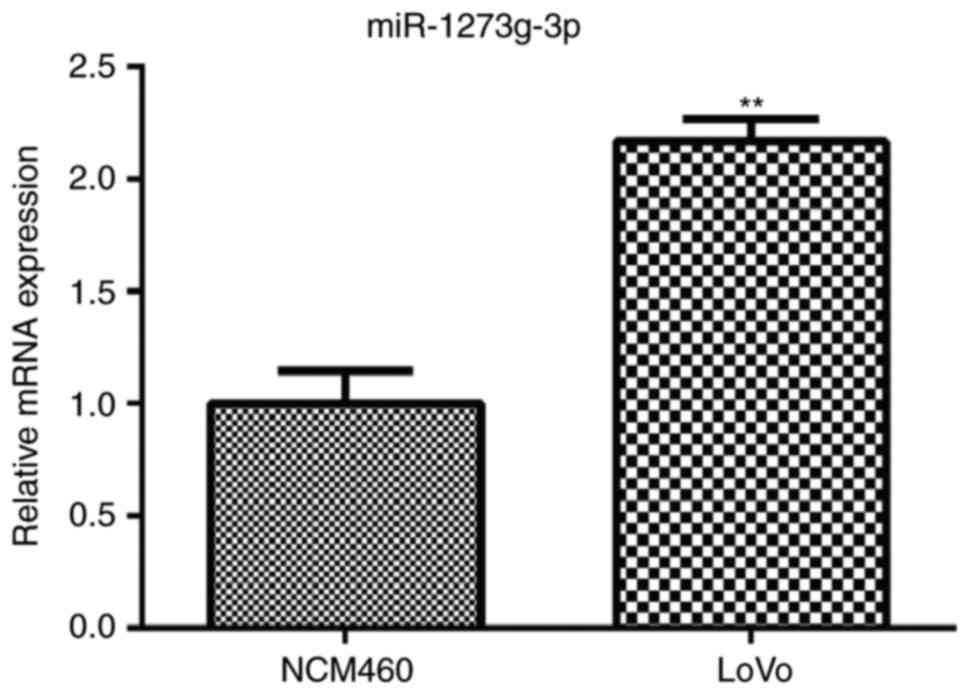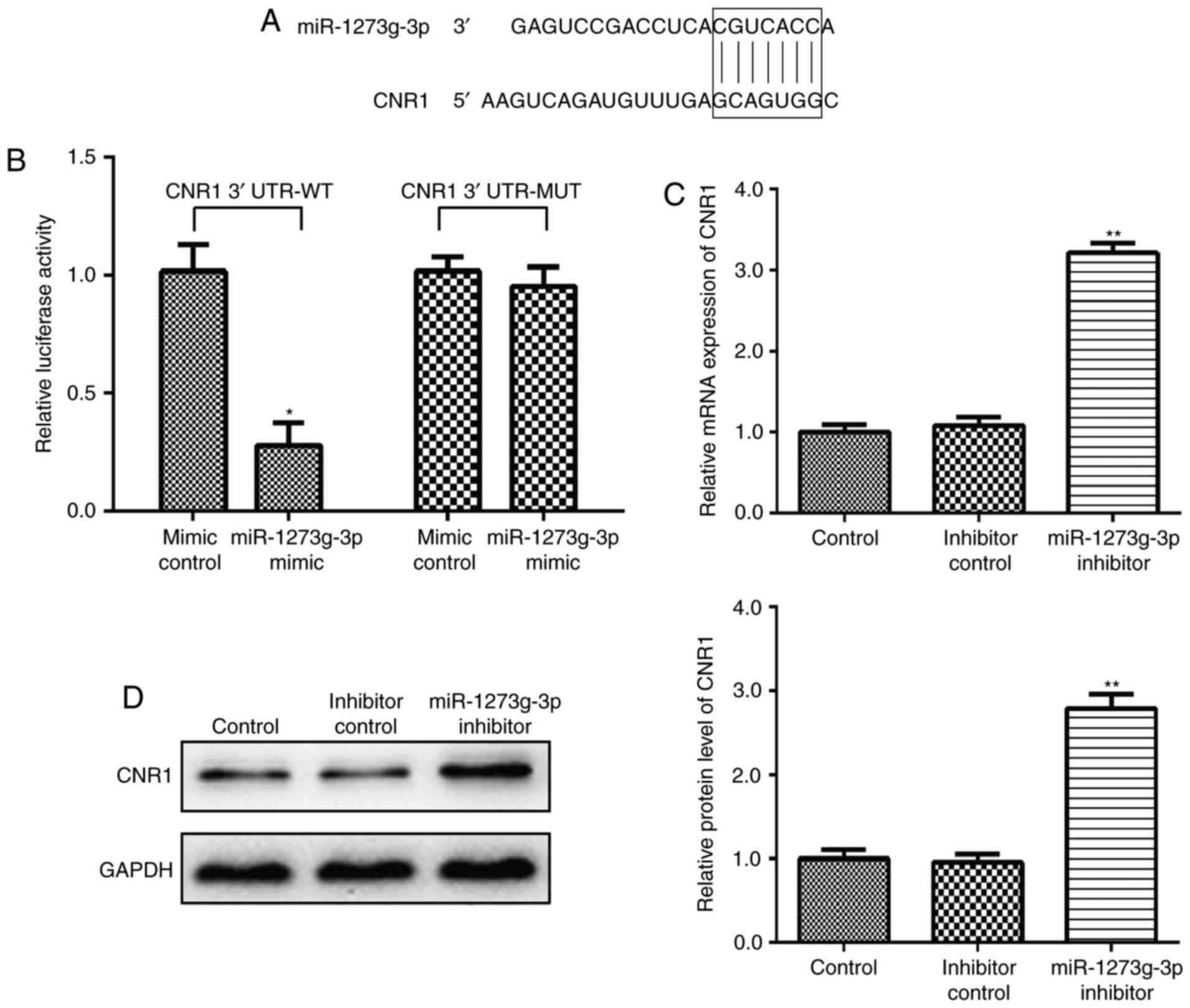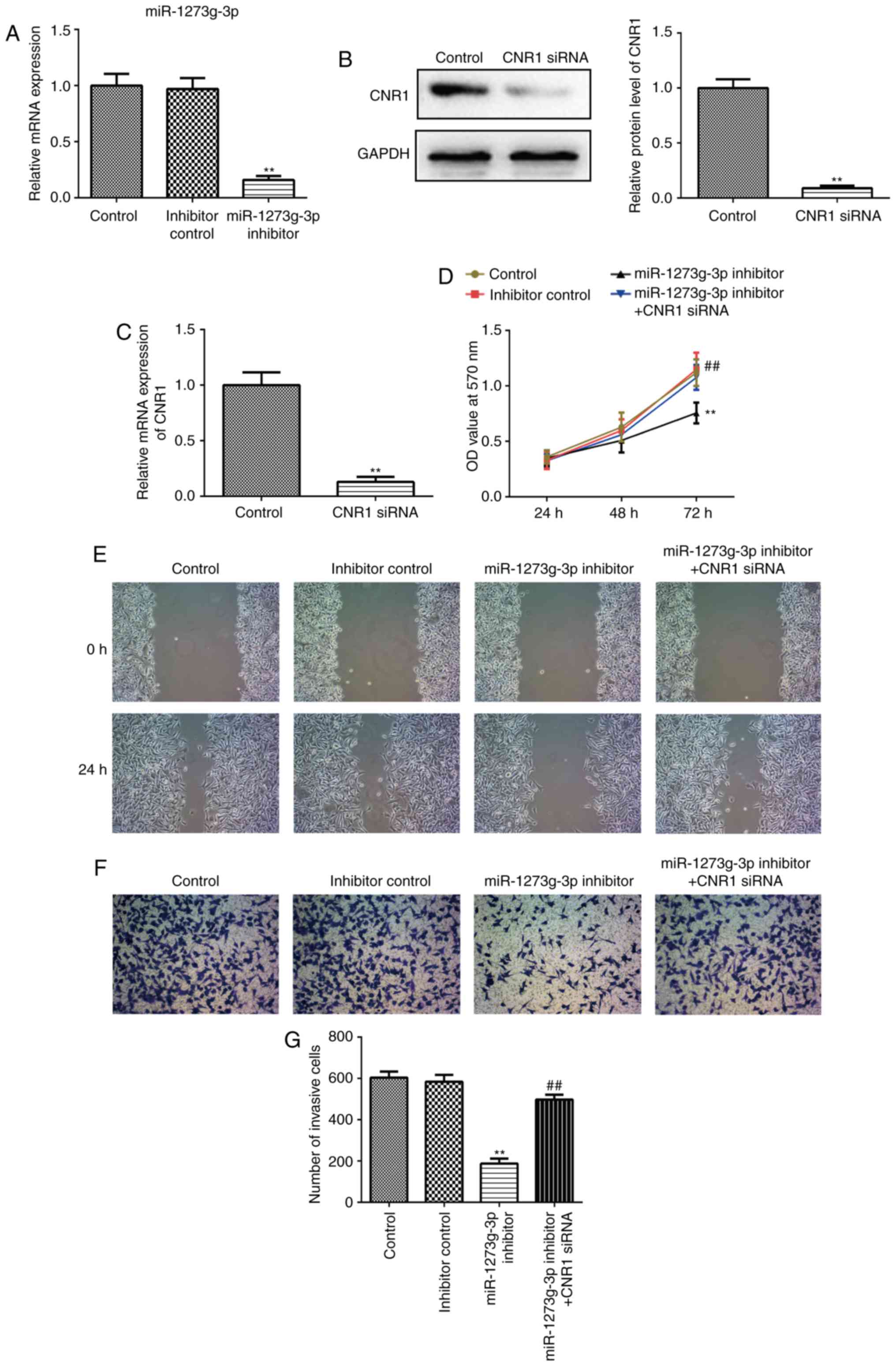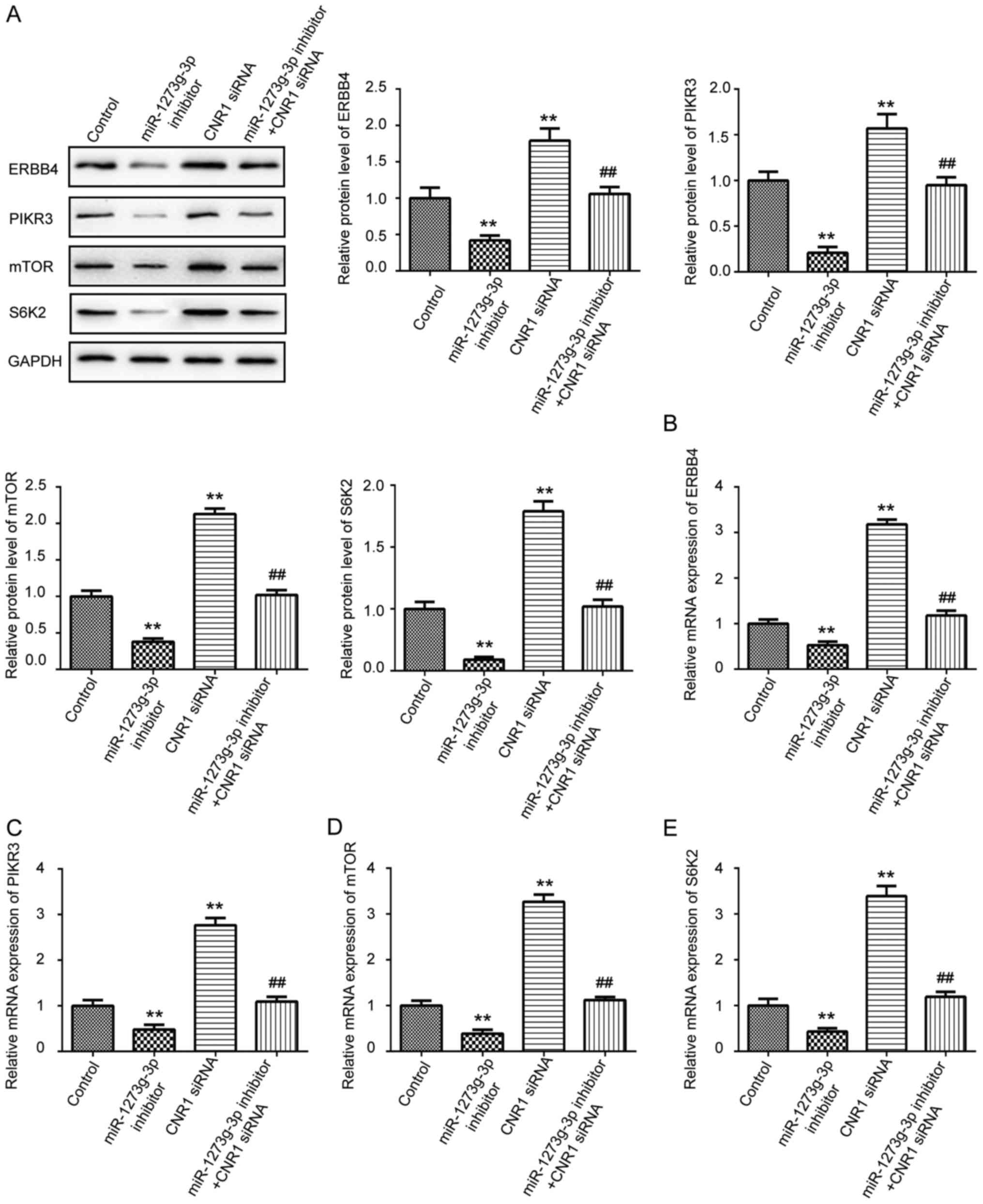|
1
|
Xie H, Sun X, Piao Y, Jegga AG, Handwerger
S, Ko MS and Dey SK: Silencing or amplification of endocannabinoid
signaling in blastocysts via CB1 compromises trophoblast cell
migration. J Biol Chem. 287:32288–32297. 2012. View Article : Google Scholar : PubMed/NCBI
|
|
2
|
Wong MC, Ching JY, Chan VC, Lam TY, Luk
AK, Wong SH, Ng SC, Ng SS, Wu JC, Chan FK and Sung JJ: Colorectal
cancer screening based on age and gender: A cost-effectiveness
analysis. Medicine (Baltimore). 95:e27392016. View Article : Google Scholar : PubMed/NCBI
|
|
3
|
Bartel DP: MicroRNAs: Target recognition
and regulatory functions. Cell. 136:215–233. 2009. View Article : Google Scholar : PubMed/NCBI
|
|
4
|
Zhang R, Liu R, Liu C, Niu Y, Zhang J, Guo
B, Zhang CY, Li J, Yang J and Chen X: A novel role for MiR-520a-3p
in regulating EGFR expression in colorectal cancer. Cell Physiol
Biochem. 42:1559–1574. 2017. View Article : Google Scholar : PubMed/NCBI
|
|
5
|
Song B, Long Y, Liu D, Zhang W and Liu C:
MicroRNA-582 promotes tumorigenesis by targeting phosphatase and
tensin homologue in colorectal cancer. Int J Mol Med. 40:867–874.
2017. View Article : Google Scholar : PubMed/NCBI
|
|
6
|
Yu T, Li J, Yan M, Liu L, Lin H, Zhao F,
Sun L, Zhang Y, Cui Y, Zhang F, et al: MicroRNA-193a-3p and −5p
suppress the metastasis of human non-small-cell lung cancer by
downregulating the ERBB4/PIK3R3/mTOR/S6K2 signaling pathway.
Oncogene. 34:413–423. 2015. View Article : Google Scholar : PubMed/NCBI
|
|
7
|
Ivashchenko A, Berillo O, Pyrkova A and
Niyazova R: Binding sites of miR-1273 family on the mRNA of target
genes. Biomed Res Int. 2014:6205302014. View Article : Google Scholar : PubMed/NCBI
|
|
8
|
Guo J, Sang Y, Yin T, Wang B, Yang W, Li
X, Li H and Kang Y: miR-1273g-3p participates in acute glucose
fluctuation-induced autophagy, dysfunction, and proliferation
attenuation in human umbilical vein endothelial cells. Am J Physiol
Endocrinol Metab. 310:E734–E743. 2016. View Article : Google Scholar : PubMed/NCBI
|
|
9
|
Niu X, Fu N, Du J, Wang R, Wang Y, Zhao S,
Du H, Wang B, Zhang Y, Sun D and Nan Y: miR-1273g-3p modulates
activation and apoptosis of hepatic stellate cells by directly
targeting PTEN in HCV-related liver fibrosis. FEBS Lett.
590:2709–2724. 2016. View Article : Google Scholar : PubMed/NCBI
|
|
10
|
Hou L, Su X, Qin X, et al: MiR-1273g-3p
regulates A549 cell migration by targeting CNR1. J Med Mol Biol.
11:125–131. 2014.
|
|
11
|
Pisanti S, Picardi P, D'Alessandro A,
Laezza C and Bifulco M: The endocannabinoid signaling system in
cancer. Trends Pharmacol Sci. 34:273–282. 2013. View Article : Google Scholar : PubMed/NCBI
|
|
12
|
Freundt-Revilla J, Kegler K, Baumgärtner W
and Tipold A: Spatial distribution of cannabinoid receptor type 1
(CB1) in normal canine central and peripheral nervous system. PLoS
One. 12:e01810642017. View Article : Google Scholar : PubMed/NCBI
|
|
13
|
Marshall AD, Lagutina I and Grosveld GC:
PAX3-FOXO1 induces cannabinoid receptor 1 to enhance cell invasion
and metastasis. Cancer Res. 71:7471–7480. 2011. View Article : Google Scholar : PubMed/NCBI
|
|
14
|
Guzmán M, Sánchez C and Galve-Roperh I:
Control of the cell survival/death decision by cannabinoids. J Mol
Med (Berl). 78:613–625. 2001. View Article : Google Scholar : PubMed/NCBI
|
|
15
|
Sánchez MG, Ruiz-Llorente L, Sánchez AM
and Díaz-Laviada I: Activation of phosphoinositide 3-kinase/PKB
pathway by CB(1) and CB(2) cannabinoid receptors expressed in
prostate PC-3 cells. Involvement in Raf-1 stimulation and NGF
induction. Cell Signal. 15:851–859. 2003. View Article : Google Scholar : PubMed/NCBI
|
|
16
|
Livak KJ and Schmittgen TD: Analysis of
relative gene expression data using real-time quantitative PCR and
the 2(-Delta Delta C(T)) method. Methods. 25:402–408. 2001.
View Article : Google Scholar : PubMed/NCBI
|
|
17
|
Guindon J and Hohmann AG: The
endocannabinoid system and cancer: Therapeutic implication. Br J
Pharmacol. 163:1447–1463. 2011. View Article : Google Scholar : PubMed/NCBI
|
|
18
|
Greenhough A, Patsos HA, Williams AC and
Paraskeva C: The cannabinoid delta(9)-tetrahydrocannabinol inhibits
RAS-MAPK and PI3K-AKT survival signalling and induces BAD-mediated
apoptosis in colorectal cancer cells. Int J Cancer. 121:2172–2180.
2007. View Article : Google Scholar : PubMed/NCBI
|
|
19
|
Jafri MA, Al-Qahtani MH and Shay JW: Role
of miRNAs in human cancer metastasis: Implications for therapeutic
intervention. Semin Cancer Biol. 44:117–131. 2017. View Article : Google Scholar : PubMed/NCBI
|
|
20
|
Huang LX, Hu CY, Jing L, Wang MC, Xu M,
Wang J, Wang Y, Nan KJ and Wang SH: microRNA-219-5p inhibits
epithelial-mesenchymal transition and metastasis of colorectal
cancer by targeting lymphoid enhancer-binding factor 1. Cancer Sci.
108:1985–1995. 2017. View Article : Google Scholar : PubMed/NCBI
|
|
21
|
Pisanti S, Malfitano AM, Grimaldi C,
Santoro A, Gazzerro P, Laezza C and Bifulco M: Use of cannabinoid
receptor agonists in cancer therapy as palliative and curative
agents. Best Pract Res Clin Endocrinol Metab. 23:117–131. 2009.
View Article : Google Scholar : PubMed/NCBI
|
|
22
|
Proto MC, Gazzerro P, Di Croce L, Santoro
A, Malfitano AM, Pisanti S, Laezza C and Bifulco M: Interaction of
endocannabinoid system and steroid hormones in the control of colon
cancer cell growth. J Cell Physiol. 227:250–258. 2012. View Article : Google Scholar : PubMed/NCBI
|
|
23
|
Song ZH and Zhong M: CB1 cannabinoid
receptor-mediated cell migration. J Pharmacol Exp Ther.
294:204–209. 2000.PubMed/NCBI
|
|
24
|
Refolo MG, D'Alessandro R, Malerba N,
Laezza C, Bifulco M, Messa C, Caruso MG, Notarnicola M and Tutino
V: Anti proliferative and pro apoptotic effects of flavonoid
quercetin are mediated by CB1 receptor in human colon cancer cell
lines. J Cell Physiol. 230:2973–2980. 2015. View Article : Google Scholar : PubMed/NCBI
|
|
25
|
Neptune ER and Bourne HR: Receptors induce
chemotaxis by releasing the betagamma subunit of Gi, not by
activating Gq or Gs. Proc Natl Acad Sci USA. 94:pp. 14489–14494.
1997; View Article : Google Scholar : PubMed/NCBI
|
|
26
|
Arai H, Tsou CL and Charo IF: Chemotaxis
in a lymphocyte cell line transfected with C-C chemokine receptor
2B: Evidence that directed migration is mediated by betagamma
dimers released by activation of Galphai-coupled receptors. Proc
Natl Acad Sci USA. 94:pp. 14495–14499. 1997; View Article : Google Scholar : PubMed/NCBI
|
|
27
|
Howlett AC, Qualy JM and Khachatrian LL:
Involvement of Gi in the inhibition of adenylate cyclase by
cannabimimetic drugs. Mol Pharmacol. 29:307–313. 1986.PubMed/NCBI
|
|
28
|
Felder CC, Veluz JS, Williams HL, Briley
EM and Matsuda LA: Cannabinoid agonists stimulate both receptor-
and non-receptor-mediated signal transduction pathways in cells
transfected with and expressing cannabinoid receptor clones. Mol
Pharmacol. 42:838–845. 1992.PubMed/NCBI
|
|
29
|
Chen Y, Bai X, Zhang Q, Wen L, Su W, Fu Q,
Sun X, Lou Y, Yang J, Zhang J, et al: The hepatitis B virus X
protein promotes pancreatic cancer through modulation of the
PI3K/AKT signaling pathway. Cancer Lett. 380:98–105. 2016.
View Article : Google Scholar : PubMed/NCBI
|
|
30
|
Karlsson E, Pérez-Tenorio G, Amin R,
Bostner J, Skoog L, Fornander T, Sgroi DC, Nordenskjöld B, Hallbeck
AL and Stål O: The mTOR effectors 4EBP1 and S6K2 are frequently
coexpressed, and associated with a poor prognosis and endocrine
resistance in breast cancer: A retrospective study including
patients from the randomised Stockholm tamoxifen trials. Breast
Cancer Res. 15:R962013. View
Article : Google Scholar : PubMed/NCBI
|
|
31
|
Cai JQ, Xu XW, Mou YP, Chen K, Pan Y and
Wu D: Upregulation of HOXB7 promotes the tumorigenesis and
progression of gastric cancer and correlates with clinical
characteristics. Tumour Biol. 37:1641–1650. 2016. View Article : Google Scholar : PubMed/NCBI
|
|
32
|
Wander SA, Zhao D, Besser AH, Hong F, Wei
J, Ince TA, Milikowski C, Bishopric NH, Minn AJ, Creighton CJ and
Slingerland JM: PI3K/mTOR inhibition can impair tumor invasion and
metastasis in vivo despite a lack of antiproliferative action in
vitro: Implications for targeted therapy. Breast Cancer Res Treat.
138:369–381. 2013. View Article : Google Scholar : PubMed/NCBI
|













